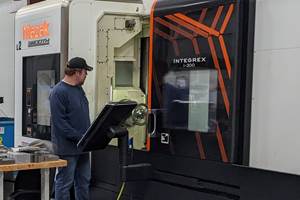Frictionless Machining Reduces Heat, Chatter
Friction resulting from moving machine components rubbing together can create vibration and heat buildup, both of which can cause problems during machining operations. One machine from NTC America uses hydrostatic components to eliminate sources of friction for high-precision, small-parts machining.
Share





When problems occur in machining operations, vibration and heat are possible culprits. Thermal growth resulting from heat buildup in the spindle can adversely affect accuracy, while vibration that causes chatter can not only ruin a cut, but also cause tools to break prematurely. In most machine tools, both vibration and heat can stem from a single source—friction caused by metal components rubbing together as the machine elements move and the spindle turns.
To eliminate friction, NTC America (Novi, Michigan) offers a machine in which the only metal-to-metal contact is between the cutting tool and the workpiece. Designed for high-precision work on small parts, the Zµ3500 VMC operates without linear guideways, roller bearings or ballscrews. Rather, it is equipped with hydrostatic ways, a hydrostatic/hydrodynamic hybrid spindle and scaled linear motor drives.
According to the company, this design provides quiet, nearly inertia-free and accurate operation, making the machine useful for the demanding requirements of medical devices and tight-tolerance dies and molds. In fact, the machine’s accuracy, rigidity and repeatability are sufficient to allow roughing, semi-finishing and finishing on a single platform, says Larry Jones, regional sales manager for NTC.
Unlike machines that use rolling, metal elements as the interface between moving and stationary components, the Zµ3500 incorporates a pressurized film of oil. Sliding along oil keeps machine components from contacting one another, eliminating friction that causes vibration and heat buildup. Moreover, having this configuration in the ways alleviates stick-slip motion, and backlash is also not a problem because the linear motors can change direction almost instantaneously, Mr. Jones says. This enables the machine to hold concentricity to less than one micron on circularity tests.
Mr. Jones likens the effect to a game of air hockey. “The components float on the film of oil like the puck floats on air,” he explains. “When you tap it, it takes off, hits a corner, and takes off another way. It looks like there’s no inertia for it to overcome.”
Many machine tools must run for a few minutes in order to “warm up” before operators can set zero points and undergo other preparations for operation. That’s because as the machine runs and temperatures increase, bearings and other metal components in the machine expand slightly and throw off accuracies, Mr. Jones says. However, with its non-metal-contact design, as well as a 60-gallon chiller unit that recirculates the hydrostatic oil and keeps it cool, the Zµ3500 is ready for machining within seconds of startup. Additionally, operators don’t need to program offsets into the control to compensate for inaccuracies resulting from thermal growth.
The machine is also much quieter than many of its counterparts because the only machining noise is that of the tool meeting the workpiece. A quieter, less-invasive shop floor can be a boon to employees, Mr. Jones says. Additionally, with no metal contact, machine components are less liable to wear out. This can extend component life and ease repair and maintenance costs. According to Mr. Jones, changing the oil every 2 years and changing the oil filter every 6 years is sufficient to maintain the hydrostatic systems.
With XYZ axis travels of 13.78 Ă— 11.81 Ă— 11.81 inches, the machine can achieve 787 ipm feed rates at a maximum spindle speed of 30,000 rpm. The worktable measures 17.72 Ă— 14.17 inches and can accommodate parts as heavy as 220 pounds. The spindle uses a 17.5/25-hp motor and HSK E32 toolholders.
Related Content
The Benefits of In-House Toolmaking
The addition of two larger gantry routers has enabled a maker of rubber belting products to produce more tooling in-house, reducing lead times and costs for itself and its sister facilities.
Read MoreIn Moldmaking, Mantle Process Addresses Lead Time and Talent Pool
A new process delivered through what looks like a standard machining center promises to streamline machining of injection mold cores and cavities and even answer the declining availability of toolmakers.
Read MoreDN Solutions America Unveils Impressive Chicago Technical Center at IMTS 2024
New tech center is serving as a cutting-edge showroom and a technological hub for advanced machining applications.
Read More5 Tips for Running a Profitable Aerospace Shop
Aerospace machining is a demanding and competitive sector of manufacturing, but this shop demonstrates five ways to find aerospace success.
Read MoreRead Next
AMRs Are Moving Into Manufacturing: 4 Considerations for Implementation
AMRs can provide a flexible, easy-to-use automation platform so long as manufacturers choose a suitable task and prepare their facilities.
Read MoreMachine Shop MBA
Making Chips and 91ĘÓƵÍřŐľÎŰ are teaming up for a new podcast series called Machine Shop MBA—designed to help manufacturers measure their success against the industry’s best. Through the lens of the Top Shops benchmarking program, the series explores the KPIs that set high-performing shops apart, from machine utilization and first-pass yield to employee engagement and revenue per employee.
Read More





















